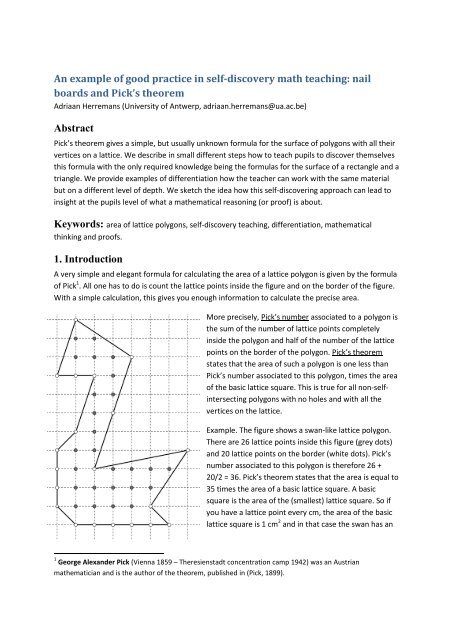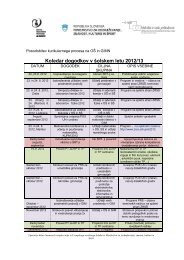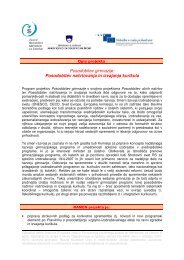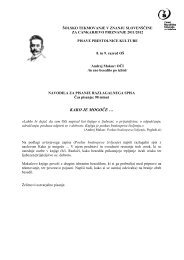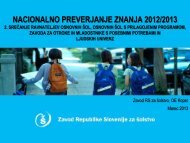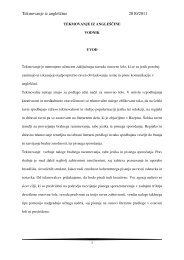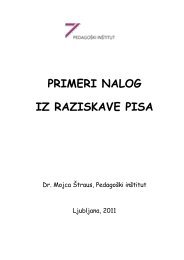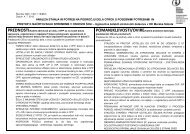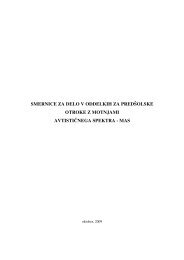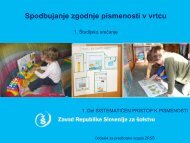nail boards and Pick's theorem Abstract 1. Introduction
nail boards and Pick's theorem Abstract 1. Introduction
nail boards and Pick's theorem Abstract 1. Introduction
You also want an ePaper? Increase the reach of your titles
YUMPU automatically turns print PDFs into web optimized ePapers that Google loves.
An example of good practice in self-discovery math teaching: <strong>nail</strong><strong>boards</strong> <strong>and</strong> Pick’s <strong>theorem</strong>Adriaan Herremans (University of Antwerp, adriaan.herremans@ua.ac.be)<strong>Abstract</strong>Pick’s <strong>theorem</strong> gives a simple, but usually unknown formula for the surface of polygons with all theirvertices on a lattice. We describe in small different steps how to teach pupils to discover themselvesthis formula with the only required knowledge being the formulas for the surface of a rectangle <strong>and</strong> atriangle. We provide examples of differentiation how the teacher can work with the same materialbut on a different level of depth. We sketch the idea how this self-discovering approach can lead toinsight at the pupils level of what a mathematical reasoning (or proof) is about.Keywords: area of lattice polygons, self-discovery teaching, differentiation, mathematicalthinking <strong>and</strong> proofs.<strong>1.</strong> <strong>Introduction</strong>A very simple <strong>and</strong> elegant formula for calculating the area of a lattice polygon is given by the formulaof Pick 1 . All one has to do is count the lattice points inside the figure <strong>and</strong> on the border of the figure.With a simple calculation, this gives you enough information to calculate the precise area.More precisely, Pick’s number associated to a polygon isthe sum of the number of lattice points completelyinside the polygon <strong>and</strong> half of the number of the latticepoints on the border of the polygon. Pick’s <strong>theorem</strong>states that the area of such a polygon is one less thanPick’s number associated to this polygon, times the areaof the basic lattice square. This is true for all non-selfintersectingpolygons with no holes <strong>and</strong> with all thevertices on the lattice.Example. The figure shows a swan-like lattice polygon.There are 26 lattice points inside this figure (grey dots)<strong>and</strong> 20 lattice points on the border (white dots). Pick’snumber associated to this polygon is therefore 26 +20/2 = 36. Pick’s <strong>theorem</strong> states that the area is equal to35 times the area of a basic lattice square. A basicsquare is the area of the (smallest) lattice square. So ifyou have a lattice point every cm, the area of the basiclattice square is 1 cm 2 <strong>and</strong> in that case the swan has an1 George Alex<strong>and</strong>er Pick (Vienna 1859 – Theresienstadt concentration camp 1942) was an Austrianmathematician <strong>and</strong> is the author of the <strong>theorem</strong>, published in (Pick, 1899).
area of exactly 35 cm 2 .In this article, we describe an example how this formula can be used to give a good lesson in selfdiscoverymath. Main objectives are the activity of pupils, <strong>and</strong> their (beginning of) underst<strong>and</strong>ing ofmathematical processes. In that way, pupils will experience that mathematics is not about “theknowledge of formulas” but about “precise (but general) description of experiences”. The relationsdescribed in formulas should become natural or evident, at least in simple situations.Pupils or teachers who took this lesson, remembered even after several years this workshop.Especially the fact that they recalled the activity (working on a <strong>nail</strong> board or geoboard) <strong>and</strong> the factthey still related counting <strong>nail</strong>s to calculate areas, convinces me of the effectiveness of this lesson.Normally in this lesson, I let pupils work in groups of four <strong>and</strong> let them work independently undersupervision. In § 5 you find an example of the written output each pupil received during this lesson.If not mentioned otherwise, we will always assume the basic lattice square has area 1 cm 2 .2. Analysis of the self-discovery lesson with <strong>nail</strong> <strong>boards</strong> on Pick’s <strong>theorem</strong>In this section we describe some points of attention while performing this kind of lesson with theworking sheets of § 5.2.1 Working in groupsAs a teacher you can divide your class into groups. I advise in this lesson to make homogeneousgroups of pupils. That makes it easier to differentiate on the content: although everybody is workingwith the same material on the same subject, there are different levels of depth possible (e.g. step 3or 7 of § 5, or § 3 to get further ideas).Pupils in one group have to cooperate: they have to make different figures, put all conclusions on asheet,… so they will (or have to) help each other.As a teacher you just assist. This means in this case: look that they are really working on theassignment, help them when a group does not underst<strong>and</strong> one or more steps in the process <strong>and</strong> lookfor counting errors especially during steps 1-4 of § 5. Since as a teacher, you already know Pick’s<strong>theorem</strong>, you can easily see when they made an error in counting <strong>nail</strong>s or in calculating areas.2.2 Self-discoveryThe purpose of this lesson is to get the pupils aware of the fact that mathematical formulas come in anatural way. Therefore, the emphasis lies not on the elegant formula but on the activity. Pupilsshould discover the formula more or less themselves as an ‘obvious relation’ they can read of theirtable of conclusions. The intellectual guidance as a teacher, mainly consists of the different steps youprepared for them in the text.After doing this kind of lesson, one should have a discussion with the pupils talking about theirexperiences. I mostly recall another example of generalization of obvious thoughts: calculation rulesfor adding, subtracting…. since generalization is a basic idea in doing mathematics. Of course, whiledoing this kind of activity, you also train their ability of fulfilling different steps with great accuracy.
Thus it is important that pupils put their thoughts into concrete <strong>and</strong> exact words while working. Soyou ask not only for the intermediate results but they have to describe in words what <strong>and</strong> why theyare working the way they do (steps 2, 5, 6, 7 of § 5).2.3 Words are more important than the formulaEven the main result, Pick’s <strong>theorem</strong>, is stated in words (step 5 of § 5), although we try to be precise.I do not think that pupils gain a better insight of this formula by introducing formulas or symbols.Therefore I do not see extra value in introducing N i (or N b ) as the number of <strong>nail</strong>s inside (or on theborder of) the polygon when working with pupils. Nevertheless it is a good <strong>and</strong> difficult exercise toformulate with accuracy what the right conclusions are. This gives pupils the insight that its takestime to come to a statement that is ‘mature’. Make sure you make them aware of this mathematicalprocess, since most of the time a formula (in Belgium) is given as a fact, without experiencing thedifficulties in order to get to such a statement.2.4 Working sheets in Slovene (see § 5)Some comments on the working sheets. In order to use for younger children, you have to use a littleless text <strong>and</strong> more figures <strong>and</strong> symbols. It makes it also easier when every step starts at a new page.Make sure that you give enough little steps to come to the conclusion but keeps every step nontrivial.This is a difficult balance when performing this kind of lesson. Don’t be afraid of adapt theworking sheets to the level of your pupils. It possibly takes some time as a teacher to have goodbalanced working sheets for the pupils you are working with.As pointed out in § 2.2, make sure you leave some (more) space (than in the example) to let pupilsreflect on their actions <strong>and</strong> put these into words. When pupils are not used to put their way ofthinking into words, this may take some help. Draw their attention to the accuracy of their writings.Working with the geoboard creates the possibility of a personal touch to this mathematical lesson. Inthis basic lesson, you see this in step 6d. You should really insist that they make a personal figure, nota boring triangle. The <strong>nail</strong> board gives them the opportunity to make something beautiful: a flower, ahockey stick… something in their daily interest. They will remember for a long time that they did this.3. Beyond the st<strong>and</strong>ard formulaIf you use this lesson at a latter age, it is possible to get your pupils acquainted with mathematicalthinking <strong>and</strong> even with the ingredients of a proof.3.1 Non-square latticesYou normally work with a st<strong>and</strong>ard lattice: this means perpendicular axis <strong>and</strong> 1 cm between <strong>nail</strong>s, sothe basic lattice quadrilateral is a square of 1 cm 2 . In step 7a-b of § 5, we suggest some questionsconcerning ratios. What happens if the distance between <strong>nail</strong>s is multiplied by two? Then the area ismultiplied by four. So in fact the Pick’s <strong>theorem</strong> shows that the area of the lattice polygon is the areaof the basic lattice square, multiplied by Pick’s number minus one.You can also change your lattice by making the basic lattice quadrilateral a rectangle (left figure) oreven a parallelogram (right figure). The conclusion remains the same.
3.2 Figures with holesIn the same self-discovery way of working, you can give pupils to examine the following figure with ahole in it (step 7e of § 5).Basically Pick’s formula concerns a topological invariant. So let your studentsfill the table of conclusions (see § 5) for this figure, <strong>and</strong> notice that the originalstatement of Pick’s <strong>theorem</strong> no longer holds. For the younger pupils, you c<strong>and</strong>escribe it as a figure with an inside <strong>and</strong> an outside border, so you need twonon-intersecting elastic b<strong>and</strong>s to create it.They should detect by looking at the last two columns in the sheet “Table ofconclusions” that they can easily adapt the formula for the area of figures with one hole. Theconclusion should be that “minus 1” in the original formula seems to disappear. In other words,Pick’s number associated to the polygon is equal to its area. So the number of <strong>nail</strong>s inside the figureplus half of the number of <strong>nail</strong>s on the border is now exactly the area of such figures.A step further for the fast students will contain the situation of multipleholes in a lattice polygon. It is always a surprise for pupils that the numberof holes, or in their language, the number of elastic b<strong>and</strong>s you need to buildyour figure, determines the formula you should use for calculating the area.In words, one can conclude that “the area of a polygon with vertices on the<strong>nail</strong>s of a <strong>nail</strong> board is equal to the sum of all <strong>nail</strong>s completely inside thefigure <strong>and</strong> half the number of <strong>nail</strong>s on its border, minus 2 plus the number ofelastic b<strong>and</strong>s you need to make the figure on the board.” With theterminology of holes, this sounds like “the area of a polygon with vertices onthe <strong>nail</strong>s of a <strong>nail</strong> board is equal to the sum of all <strong>nail</strong>s completely inside thefigure <strong>and</strong> half the number of <strong>nail</strong>s on its border minus 1 plus the number ofholes inside your figure.”The latter formulation is closer to the original statement of Pick <strong>and</strong> therefore pupils prefer that one.The formula is simple <strong>and</strong> beautiful. Nevertheless one should emphasize the mathematical way ofthinking, which comes in a natural way. It consists of three steps:1° one has a nice formula that seems to work properly;
2° one encounters a figure, where the formula does not work anymore;3° one looks for adaptations of the original formula in order to state a more general/preciseconclusion.Next to that, pupils can get an idea of a real proof in this setting. Considering the figure with holes asa difference between lattice polygons, one gets the immediate result. Indeed, the polygon withoutside border minus all polygons which form the holes, are all lattice polygons <strong>and</strong> therefore theoriginal Pick formula holds for all these lattice polygons. This provides a waterproof argument (orproof) of the conclusion you already discovered by looking at the relationship between area <strong>and</strong>counting <strong>nail</strong>s.3.3 Self-intersecting figuresOther figures where the original formula does not hold any more, <strong>and</strong> which are makeable on the<strong>nail</strong> board with just one elastic b<strong>and</strong>, are self-intersecting figures.This intersection may happen exactly on a lattice point/<strong>nail</strong> (left figure), or not(two right figures).For the left figure, one gets that the area equals Pick’snumber minus 3/2. For the right figures, there is nohope for a simple formula: both figures have the samePick number since they both have 4 <strong>nail</strong>s on the border. Neverthelessthey have a different area.So pupils have to be very careful here. The easiest way to formulate the conclusion is the followingone: the original formula of Pick’s <strong>theorem</strong> has to be adjusted by subtracting half of the multiplicityof the intersection <strong>nail</strong>. The multiplicity equals the number of times that the <strong>nail</strong> is crossed whenfollowing the whole border when you start (<strong>and</strong> also end) in theintersection <strong>nail</strong>. Start <strong>and</strong> finish are not counted, so a nonintersectionmail gets multiplicity zero! For the above figures, themultiplicity of the intersection <strong>nail</strong> equals one. For the figure onthe right this multiplicity is equal to four.The upper left figure gives you 7 points on the border. This givesyou a Pick number of 7/2. There is one intersection point ofmultiplicity one, so you should subtract 1 (from original Pick’sformula) <strong>and</strong> a half (from the intersection point with multiplicity1) from it. This gives you the correct area of 2 cm 2 .Notice that when intersection points are on the <strong>nail</strong>s, you can see the figure as a sum of differentlattice polygons where the original Pick’s <strong>theorem</strong> holds. In this way, one underst<strong>and</strong>s that theintersection <strong>nail</strong>s are counted more than once. For the example figure on the right side, theintersection point is counted five times when you see this as a sum of five lattice triangles, but alsothe “minus 1” occurs five times.What do you have to do when intersection points are not on the lattice? At first sight no easyformula can be possible (see remark above). But when you think of § 3.1 the answer is relatively
easy: just choose another lattice that is suited for your figure. ‘Suited’here means that every intersection point lies on a lattice point. Forthe upper right figures, one can choose a lattice where the distancebetween <strong>nail</strong>s is half the distance of the original one. Using theformula for self-intersecting polygons <strong>and</strong> using that the new basiclattice square is ¼ of the old one, you can again calculate the area bycounting <strong>nail</strong>s. Remark that it is always possible to choose a suitablelattice.I usually leave the part of intersection points on the lattice for the gifted children. The part ofintersection points outside the lattice is only used as a challenge for thevery gifted.Again one can get to the more general case where there is more thanone intersection point. Pick’s <strong>theorem</strong> can be adapted by subtractinghalf of the multiplicity of every intersection <strong>nail</strong>.3.4 Combining the previousOnce you treated more than one situation of § 3.1 - 3.3 seperatly, you can combine them. This givespupils to calculate areas of following figures just by counting <strong>nail</strong>s <strong>and</strong> adjust Pick’s <strong>theorem</strong> in theright way.Conclusion: the area of a polygon made by elastic b<strong>and</strong>s on a <strong>nail</strong> board with only intersection pointson <strong>nail</strong>s, equals the area of the basic lattice quadrilateral timesPick’s number (which is the sum of <strong>nail</strong>s completely inside the figure <strong>and</strong> half of the <strong>nail</strong>s on theborder)PLUS the number of holesMINUS half the number of intersection <strong>nail</strong>s (times their multiplicity)MINUS one.Almost equivalent <strong>and</strong> a little bit easier is: when a polygon has intersection <strong>nail</strong>s, divide the figureinto different subfigures each without intersection <strong>nail</strong>s. The area of each subfigure can be calculatedby Pick’s number PLUS the number of holes MINUS one.
Remark that the second formulation cannot deal with the figureaside. The intersection <strong>nail</strong> cannot be removed by splitting thefigure into two subfigures.3.5 What is a proof all about?The original <strong>theorem</strong> of Pick has been taken for granted, based on evidence. Nevertheless, oncepupils have seen some of the simple counterexamples in the previous sections, you can ask them fora proof of the <strong>theorem</strong>. The right question to ask is: how should you build arguments in order to beabsolutely sure that Pick’s original <strong>theorem</strong> is true for non-intersecting polygons with no holes.If you look in the literature, one finds a lot of different <strong>and</strong> elegant proofs (Dubeau <strong>and</strong> Labb, 2007),(Grünbaum <strong>and</strong> Shephard, 1993), (Pullman, 1979), (Tant, 2006), (Varberg, 1985). Nevertheless noneof them is evident; most of the time it involves additivity of a certain function.If you look at the first steps of the lesson (steps 1-3 of § 5) they may have an idea. First take theeasiest polygons: rectangles with sides parallel to the lattice <strong>and</strong> rectangular triangles where bothsides that form the right angle are again parallel to the lattice.The formula of Pick can be checked for the rectangles, since it is both easy to calculate the area aswell as to count the number of <strong>nail</strong>s. Remark the triangles are just half of such rectangle <strong>and</strong>therefore Pick’s <strong>theorem</strong> follows easily.polygon.The main step is proving additivity. More precise: iftwo lattice polynomials share a (part of a) side, <strong>and</strong>Pick’s <strong>theorem</strong> holds for both polygons, then it holdsalso for the polygon which is the union of both.In the example both polygons share segment AB.You can see that every inside <strong>nail</strong> remains inside;<strong>nail</strong>s on the border, remain on the border except forthe <strong>nail</strong>s on the segment AB (point C in the figure).These <strong>nail</strong>s become inside <strong>nail</strong>s in the great polygon.But this type of <strong>nail</strong>s are no problem for Pick’sformula since they are counted twice as half a <strong>nail</strong>when looking at the two smaller polygons separately<strong>and</strong> once as an inside <strong>nail</strong> when looking at the bigPoints A <strong>and</strong> B play the key role. They are counted twice as a border <strong>nail</strong> when looking at the twosmall polygons separately, while they only should be counted once as a border <strong>nail</strong> of the greaterpolygon. Nonetheless this makes up for the fact that when adding Pick’s <strong>theorem</strong> for the twopolygons separately, you get twice the term “minus 1”. Therefore one concludes that Pick’s <strong>theorem</strong>still holds for the union of two polygons that share a segment.Once you know the sum, you can also conclude that Pick’s <strong>theorem</strong> still st<strong>and</strong>s for the difference oftwo polygons sharing (part of) a side, where the smaller one completely lies in the bigger one.The last step consists in the fact that every lattice polygon can be written as sum <strong>and</strong> difference ofdifferent basic rectangles <strong>and</strong> rectangular triangles as described in the first step (see step 3 of § 5 toget an idea). This goes in fact about tiling a lattice polygon, <strong>and</strong> remains at an intuitive level.
This kind of proof exercise is only useful for pupils with good math skills. Nevertheless, it contains alot of exemplary information of how a mathematical proof works. They at least experience that,although the evidence of the formula is overwhelming, it still takes several non-trivial steps toactually be completely sure that it always holds. It this we can recognize three major steps:1° check the statement in easy conditions;2° move from there to more difficult situations;3° try to proof that you can consider every situation when step 1 <strong>and</strong> 2 are known.4. ConclusionPick’s <strong>theorem</strong> can be used in class in a self-discovery way. Some teachers already use this <strong>theorem</strong>in class, most of the time emphasizing on calculating the areas of strange figures <strong>and</strong> creativity inbuilding figures.But the easiness <strong>and</strong> unfamiliarity of the formula creates the opportunity for discoveringmathematical thinking. Pupils are often surprised they can discover formulas themselves <strong>and</strong> gainmathematical confidence out of it. Going beyond the st<strong>and</strong>ard formula, you can give pupils a glimpseof what is mathematical activity is all about: searching for more general statements when youencounter counterexamples by investigating several examples <strong>and</strong> trying to find an argument why italways works.The <strong>nail</strong> board gives pupils the chance to do this investigation themselves <strong>and</strong> leaves some space forcreativity (e.g. steps 6d or 7e in § 5). There are applets on the internet, but they might do all countingfor you <strong>and</strong> are not capable of dealing with figures with holes or self-intersections (see [6]).Nevertheless other people developed similar material, e.g. [7] where you can find a geoboard appletthat allows figures with holes.Since there are a variety of figures where one has to adapt Pick’s <strong>theorem</strong>, it is perfectly doable todifferentiate in a lesson both in depth <strong>and</strong> in steps, while working with the same material. Motivateyour pupils to make personal figures whenever they get the chance. This will enlarge theirappreciation for math <strong>and</strong> give them more confidence.I would just encourage teachers to incorporate lessons that focus on math thinking. Therefore Iinclude an example of working sheets one can use in such a lesson. I hope you’ll enjoy it, <strong>and</strong> just feelfree to contact me for advice or to share your feedback.5. Appendix: an example of working sheets to use in class (in Slovene)See added Word-files, or look at p. 649-655 in the conference proceedingshttp://www.zrss.si/pdf/zbornikprispevkovkupm2012.pdfReferences<strong>1.</strong> Dubeau F. <strong>and</strong> Labb S. (2007), Euler’s Characteristic <strong>and</strong> Pick’s <strong>theorem</strong>, Int. J. Contemp.Math. Sciences, Vol. 2, no. 19, p. 909 – 9282. Grünbaum B. <strong>and</strong> Shephard G.C. (1993), Pick’s <strong>theorem</strong>, Amer. Math. Monthly, 100, p. 150-1613. Pick G.A. (1899), Geometrisches zur Zahlentheorie, Sitzungber. Lotos, NaturwissenZeitschrift Prague, 19, p. 311-319.
4. Pullman H.W. (1979), An Elementary Proof of Pick’s Theorem, School Science <strong>and</strong>Mathematics, p. 7-125. Tant D. (2006), De stelling van Pick, Wiskunde & Onderwijs 125, p. 39-446. Varberg D.E. (1985), <strong>Pick's</strong> Theorem Revisited, Amer. Math. Monthly 92, p. 584 – 5877. http://www.cut-the-knot.org/ctk/Pick.shtml (20.07.2011)8. http://illuminations.nctm.org/LessonDetail.aspx?ID=L623 (20.07.2011)


